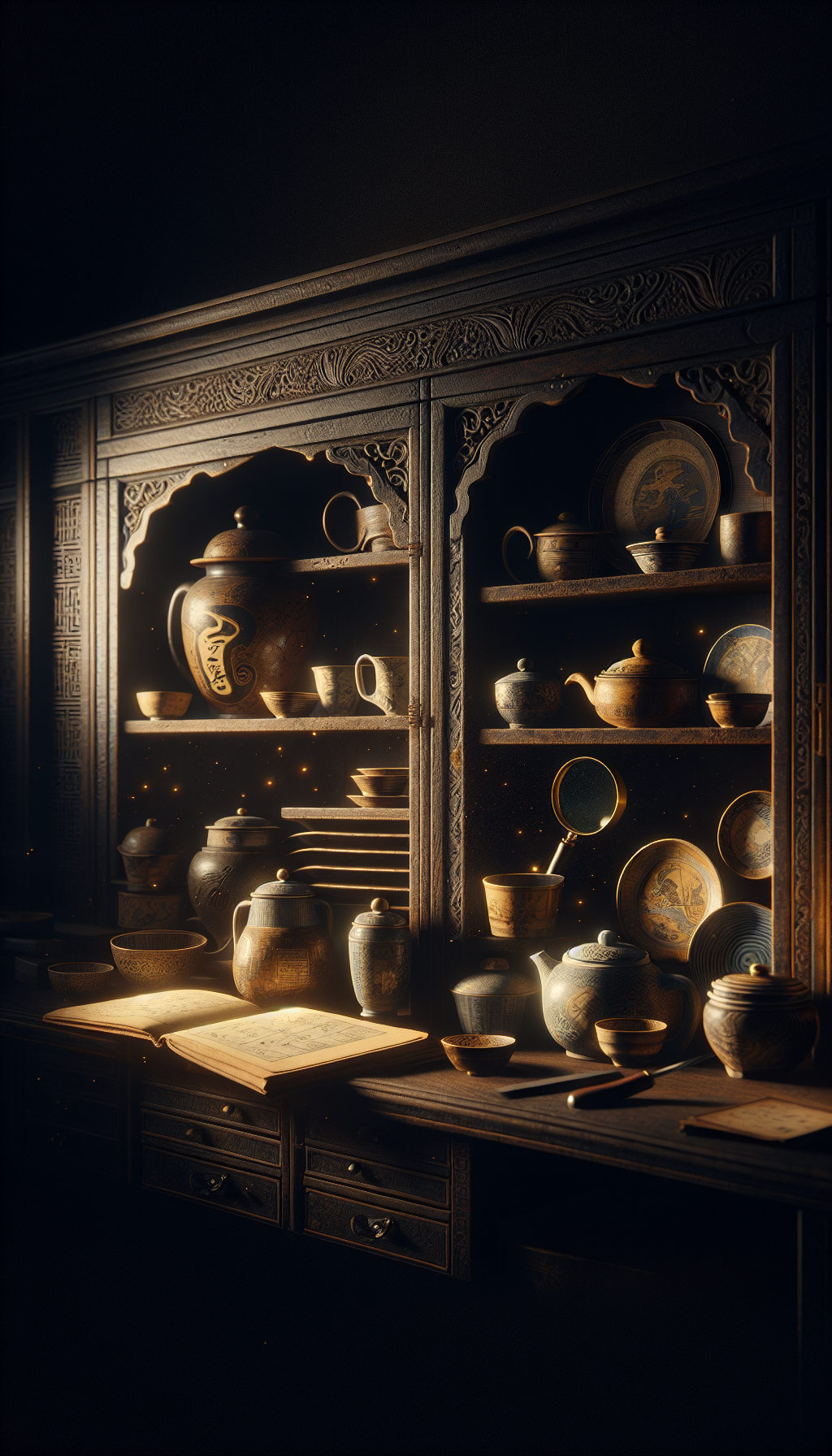A Very Rare Chinese Porcelain Trunk Vase Qianlong Mark Circa Early 20th Century
Chinese porcelain labeled “Qianlong mark” often excites collectors—yet the reality behind those four words is nuanced. Many early 20th-century vases bear apocryphal Qianlong reign marks as tributes to the 18th-century high Qing aesthetic. Among them, the so-called “trunk vase” form stands out: a sculptural, bark-textured body that mimics a gnarled section of tree. For appraisers and enthusiasts, distinguishing an early 20th-century example from 18th-century imperial work—and from later reproductions—rests on reading the body, glaze, enamels, base, and mark together.
This guide explains what defines a trunk vase, why a Qianlong mark appears on early 20th-century pieces, how to authenticate and grade quality, and what matters for appraisal.
The Trunk Vase Form and Decoration
“Trunk vase” describes a sculpted porcelain vessel modeled to resemble a tree trunk, typically with:
- A cylindrical or irregularly lobed body with molded bark texture, knots, and fissures.
- Relief “burls” and occasional applied branches or prunus (plum) blossoms.
- An irregular mouth rim, sometimes undulating like sawn wood.
- A mostly glazed interior (white or celadon-tinted) and a dry, unglazed foot rim.
Historically, trunk-form ceramics appear from the late Qing onward, with the form gaining popularity into the Republic period (1912–1949) through Jingdezhen’s revivalist studios. Decoration varies:
- Faux-bois (muhua) ground: Brown, tan, or chocolate-brown glazes and enamels to simulate bark, often with darker lines and stippling for grain.
- Applied ornament: Molded prunus sprays, lingzhi fungus, or squirrels, birds, and insects.
- Famille rose panels: On some higher-grade Republic examples, a bark ground frames figural or floral panels with delicate linework and inscriptions.
- Monochromes: Less common, but robin’s-egg or tea-dust type glazes appear on sculptural forms, seeking archaic resonance.
Republic-era artists prized naturalistic modeling, crisp relief, and a painterly bark effect. The best examples show sophisticated shading, convincing knots, and subtle transitions where applied elements meet the trunk.
Dimensions vary widely (roughly 18–45 cm in height is common). Weight tends toward the substantial due to the thick, molded body.
Qianlong Mark in the Republic Era: Authenticity, Rarity, and Intent
Seeing a Qianlong mark (Da Qing Qianlong Nian Zhi) on an early 20th-century vase raises two immediate questions: Is it 18th century? And why use that mark?
- Apocryphal homage: From the late 19th century into the Republic period, Jingdezhen decorators frequently used earlier imperial marks as honorifics, signaling stylistic allegiance rather than asserting period authenticity. A six-character seal-script Qianlong mark on a trunk vase made circa 1900–1930 is common and not deceptive in period context; it functioned as a sign of quality and taste.
- Rarity versus scarcity: The phrase “very rare” is overused in sale listings. True rarity comes from exceptional modeling, master-level painting, unusual glaze combinations, inscriptions by known studio artists (for example, painters of the Zhushan circle), outstanding size or condition, or documented provenance. A standard trunk vase with a Qianlong mark from the early 20th century is collectible but not inherently rare.
- Period tell-tales: Qianlong-of-the-period trunk vases are extraordinarily scarce, and their overall feel differs—paste, glaze tone, enamel chemistry, foot finishing, and brushwork signal mid-18th-century imperially supervised work. Most “Qianlong mark” trunk vases encountered today date to the early 20th century.
For appraisal, a correct early 20th-century attribution is often a positive: collectors value Republic-era craftsmanship. Pricing grades upward sharply with artistry, inscriptions, and condition.
Hands-On Identification: Body, Glaze, and Enamels
Correctly dating a trunk vase involves looking beyond the mark. Assess the body, glaze, and enamel work closely under magnification.
Body and modeling
- Paste and weight: Republic porcelain bodies are dense and ring with a bright tone when tapped lightly; the weight feels solid due to sculptural thickness. Interiors are usually smoothly potted with even walls.
- Molded bark: Look for crisp tooling along “growth rings,” naturalistic knots, and undercutting at applied elements. Soft, smeared details can indicate later, lower-quality production.
- Seam evidence: Some trunk vases show subtle mold seams; better examples disguise joins through hand-finishing and enamel shading.
Glaze and ground
- Ground glaze: A clean, bright white glaze with a faint bluish cast is typical of Republic Jingdezhen; it levels smoothly with fine, evenly spaced micro-bubbles visible under 10x magnification. Genuine age yields scattered pinholes or tiny burst bubbles; avoid heavy, deliberate “antiquing.”
- Bark coloration: Faux-wood grounds are built from layered iron-brown, sepia, and black enamels over the glaze. Expect controlled variation and shading; pooling at recesses is normal. Excessively uniform “printed” grain can suggest transfer techniques.
- Staining and wear: Natural wear shows at high-relief points, rim edges, and on applied blossoms. Gilt, if present, will thin at contact points. Deep, even brown staining seeping into unglazed areas may be artificial.
Enamels and palette
- Famille rose technique: Republic enamels often appear pastel and slightly translucent, with fine iron-red or grey outlining. Brushstrokes in leaves and petals should taper gracefully. Over-glaze enamel sits in low relief and can show minute crackle when aged.
- Calligraphy: If the vase includes inscriptions, evaluate the hand—fluid, confident characters with rhythmic modulation indicate an accomplished painter. Stiff, uniform strokes are a caution.
- Artist seals: Some Republic artists applied red seals in enamel alongside inscriptions. Cross-compare style to known hands if attribution is suggested, but beware spurious seals.
Condition clues
- UV light: Old restorations fluoresce differently (chalky green-blue) compared to stable porcelain. Expect touch-ups at blossom tips, rim frits, and trunk burls. Broad fluorescent patches can conceal major repairs.
- Sound: A continuous, clear ring indicates structural integrity; a dull thud may signal a hairline or filled area.
Underside Analysis: Foot Rim, Base, and Mark
The base often tells more truth than the decoration.
Foot rim
- Finish: Early 20th-century feet are usually neatly turned, showing shallow concentric tool lines. The biscuit is ivory to pale buff with occasional iron freckles. Kiln grit may adhere sparingly.
- Wear: Honest wear appears as smoothening and slight rounding of the edge, especially if the vase has been moved on hard surfaces. Sharp, freshly ground rims are suspicious unless accompanied by an explanation of post-firing adjustment.
Glaze and base center
- Fully glazed base centers are common on Republic pieces with the foot rim left unglazed. Look for glaze pooling slightly toward the center and a faint spiral from wheel-throwing.
- Spur marks are uncommon on these sculptural forms; if present, they should be small and consistent with the glaze surface.
The mark
- Script: A six-character seal-script mark reading Da Qing Qianlong Nian Zhi is most typical. Characters should be well-formed but can vary; many are squared and compact.
- Application: Overglaze iron-red within a double square or single square cartouche is widely seen on Republic wares. Underglaze blue marks appear but are less common on enamel-heavy pieces. Turquoise enamel marks exist on some specialized glazes.
- Touch and integration: Overglaze marks sit slightly proud of the base glaze. A printed, dot-screen appearance or bleeding lines suggests modern transfer processes. Hand-painted marks show brush entry/exit and minute variation.
- Terminology: “Apocryphal” does not mean fake; it indicates a later homage. “Of the period” Qianlong marks on trunk vases would be exceptional and require convincing corroborative features throughout.
Signs of later manufacture or altering
- Synthetic age: Tea-stained bases, grit rubbed into the foot, and artificial abrasion are common. Under magnification, true age wear looks rounded and naturally random; artificial wear has linear scratches or diffuse staining that sits on top of the glaze.
- Ground and reglued foot sections are sometimes used to disguise chips; look for short, straight micro-fissures and color mismatch under UV.
Valuation-relevant base traits
- Clean, well-executed foot and a confident, hand-painted seal mark align with better Republic output.
- Additional inscriptions or studio seals near the base can raise interest but must be judged stylistically and materially.
Practical Inspection Checklist
Form and modeling
- Naturalistic bark with crisp relief; convincing knots and undercuts.
- Balanced proportions; mouth not crudely cut or excessively oval from warping.
Glaze and enamels
- Bright, even glaze with fine micro-bubbles; no heavy artificial staining.
- Layered bark enamels with shading; hand-painted detail rather than mechanical repetition.
- Famille rose work shows tapered brushstrokes and controlled outlines.
Base and mark
- Unglazed foot rim with neat tool lines; subtle, honest edge wear.
- Hand-painted six-character Qianlong seal mark, often in iron-red, sitting slightly proud.
- No obvious transfer-dot matrix or bleeding in the mark.
Condition
- Check rim, burls, and applied blossoms for chips and reglued elements.
- UV for overpaint; look for large, fluorescent areas that hide structural problems.
- Clear ring when lightly tapped; dull tone may indicate a crack.
Context and comparables
- Early 20th-century attribution aligns with materials and style.
- Assess inscriptions/seals cautiously; premium only if credible and high-quality.
FAQ
Q: If it has a Qianlong mark, why isn’t it 18th century? A: From the late Qing into the Republic period, decorators used earlier imperial marks as honorifics. A Qianlong mark on an early 20th-century vase signals stylistic homage, not period authenticity. True Qianlong-period trunk vases are extraordinarily rare and differ in paste, glaze, and finish.
Q: How can I tell hand-painted from transfer decoration? A: Under 10x magnification, hand-painted lines exhibit varied brush pressure, tapering, and occasional microscopic overlaps. Transfers can show a dot-matrix or uniform line width with tiny breaks. On bark grounds, repeated identical grain patterns are a red flag.
Q: What condition issues most affect value? A: Structural cracks, heavy overpaint, and losses to applied elements reduce value significantly. Minor rim frits or light enamel wear are typical. Seamless, extensive restoration that changes surface texture is a major concern.
Q: Do Republic-era artist signatures matter? A: Yes. Works convincingly attributable to noted Jingdezhen painters (e.g., the Zhushan circle) command strong premiums. Verification relies on stylistic analysis, seal reading, and quality consistency; spurious signatures are common, so proceed cautiously.
Q: Is a “very rare” trunk vase a safe investment? A: “Very rare” should be supported by exceptional artistry, documented provenance, unusual size or glaze, and impeccable condition. The form itself is collectible but not inherently rare. Buy on quality and verifiable attributes, not on labels alone.
By weighing the form, glaze, enamels, base, and mark together—and by treating a Qianlong mark on a trunk vase as a Republic-era homage unless proven otherwise—you can place a piece accurately and appraise it with confidence. For high-value candidates, corroborating expertise and, where appropriate, scientific imaging help validate condition and attribution.



